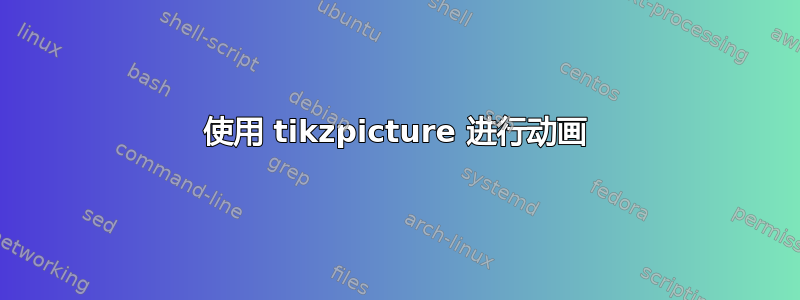
我目前有一个带有 tikzpicture 和节点的框架。但我不知道如何只显示一个节点,其他节点显示为灰色,下一帧将包含一些文本,下一帧将使第一个和第二个节点可见,其他节点保持灰色,等等...我已经尝试了“暂停”选项,但这不是我想要的...
前任:
frame1 节点 1 可见,其他节点为灰色
frame2 啦啦啦啦啦
frame3 节点 1 和 2 可见,其他为灰色..等等...
frame4 啦啦啦啦啦
我的代码是:
\documentclass{beamer}
\usepackage{tikz}
\tikzstyle{m_rectangle} = [rectangle, align=center, rounded corners, minimum width=2cm, minimum height=1.5cm, draw=black]
\tikzstyle{arrow} = [thick,->,>=stealth]
\begin{document}
\begin{frame}{Test frame}
\begin{figure}
\centering
\vspace{-.3cm}
\begin{tikzpicture}[node distance=2cm]
\hspace{-.5cm}
\node (in) [m_rectangle, fill=red!30] {1};
\node (chapeau) [m_rectangle, right of=in, xshift=1cm, fill=blue!30] {2};
\node (fortran) [m_rectangle, below of=chapeau, yshift=-.1cm, fill=yellow!30] {3};
\node (all) [m_rectangle, right of=chapeau, xshift=1.5cm, fill=green!30] {4};
\node (fiab) [m_rectangle, above of=all, yshift=.1cm, fill=green!30] {5};
\node (moy) [m_rectangle, below of=all, yshift=-.1cm, fill=green!30] {6};
\node (out) [m_rectangle, right of=all, xshift=1cm, fill=red!30] {7};
\draw [arrow] (in) -- (chapeau);
\draw [arrow] (in) -- (fortran);
\draw [arrow] (chapeau) -- (fortran);
\draw [arrow] (chapeau) -- (fiab);
\draw [arrow] (chapeau) -- (all);
\draw [arrow] (chapeau) -- (moy);
\draw [arrow] (out) -- (fiab);
\draw [arrow] (out) -- (all);
\draw [arrow] (out) -- (moy);
\end{tikzpicture}
\caption{Figure caption}
\end{figure}
\end{frame}
\end{document}
提前谢谢大家,
懒猴
答案1
我不太清楚你到底想要什么,但你大概可以通过使用来实现你想要的
\setbeamercovered{transparent}
这将使覆盖的项目变得透明,并且
\uncover<>{}
围绕不总是完全可见的节点
\documentclass{beamer}
\usepackage{tikz}
\tikzstyle{m_rectangle} = [rectangle, align=center, rounded corners, minimum width=2cm, minimum height=1.5cm, draw=black]
\tikzstyle{arrow} = [thick,->,>=stealth]
\begin{document}
\begin{frame}{Test frame}
\setbeamercovered{transparent}
\begin{figure}
\centering
\vspace{-.3cm}
\begin{tikzpicture}[node distance=2cm]
\hspace{-.5cm}
\node (in) [m_rectangle, fill=red!30] {1};
\uncover<2>{\node (chapeau) [m_rectangle, right of=in, xshift=1cm, fill=blue!30] {2};}
\node (fortran) [m_rectangle, below of=chapeau, yshift=-.1cm, fill=yellow!30] {3};
\node (all) [m_rectangle, right of=chapeau, xshift=1.5cm, fill=green!30] {4};
\node (fiab) [m_rectangle, above of=all, yshift=.1cm, fill=green!30] {5};
\uncover<3>{\node (moy) [m_rectangle, below of=all, yshift=-.1cm, fill=green!30] {6};}
\node (out) [m_rectangle, right of=all, xshift=1cm, fill=red!30] {7};
\draw [arrow] (in) -- (chapeau);
\draw [arrow] (in) -- (fortran);
\draw [arrow] (chapeau) -- (fortran);
\draw [arrow] (chapeau) -- (fiab);
\draw [arrow] (chapeau) -- (all);
\draw [arrow] (chapeau) -- (moy);
\draw [arrow] (out) -- (fiab);
\draw [arrow] (out) -- (all);
\draw [arrow] (out) -- (moy);
\end{tikzpicture}
\caption{Figure caption}
\end{figure}
\end{frame}
\end{document}
答案2
我使用 tikz 的不透明度功能解决了这个问题。
比照:
\documentclass[10pt]{beamer}
\mode<presentation>
{
\usetheme{Warsaw}
\setbeamercovered{transparent}
}
\usepackage{tikz}
\tikzset{invisible/.style={opacity=0.1},
visible on/.style={alt={#1{}{invisible}}},
alt/.code args={<#1>#2#3}{%
\alt<#1>{\pgfkeysalso{#2}}{\pgfkeysalso{#3}}
},
}
\tikzstyle{m_rectangle} = [rectangle, align=center, rounded corners, minimum width=2cm, minimum height=1.5cm, draw=black, visible on=<1->]
\tikzstyle{i_rectangle} = [rectangle, align=center, rounded corners, minimum width=2cm, minimum height=1.5cm, draw=black, invisible]
\tikzstyle{arrow} = [thick,->,>=stealth, visible on=<1->]
\tikzstyle{i_arrow} = [thick,->,>=stealth, invisible]
\begin{document}
\begin{frame}{Test}
\begin{figure}
\centering
\vspace{-.3cm}
\begin{tikzpicture}[node distance=2cm]
\hspace{-.5cm}
\node (in) [m_rectangle, fill=red!30] {1};
\node (chapeau) [i_rectangle, right of=in, xshift=1cm, fill=blue!30] {2};
\node (fortran) [i_rectangle, below of=chapeau, yshift=-.1cm, fill=yellow!30] {3};
\node (all) [i_rectangle, right of=chapeau, xshift=1.5cm, fill=green!30] {4};
\node (fiab) [i_rectangle, above of=all, yshift=.1cm, fill=green!30] {5};
\node (moy) [i_rectangle, below of=all, yshift=-.1cm, fill=green!30] {6};
\node (out) [i_rectangle, right of=all, xshift=1cm, fill=red!30] {7};
\draw [i_arrow] (in) -- (chapeau);
\draw [i_arrow] (in) -- (fortran);
\draw [i_arrow] (chapeau) -- (fortran);
\draw [i_arrow] (chapeau) -- (fiab);
\draw [i_arrow] (chapeau) -- (all);
\draw [i_arrow] (chapeau) -- (moy);
\draw [i_arrow] (out) -- (fiab);
\draw [i_arrow] (out) -- (all);
\draw [i_arrow] (out) -- (moy);
\end{tikzpicture}
\caption{Block diagram}
\end{figure}
\end{frame}
\begin{frame}{Test}
\begin{itemize}
\Large{
\item BlaBlaBla
\item BlaBlaBla
\item BlaBlaBla
}
\end{itemize}
\end{frame}
\begin{frame}{Test}
\begin{figure}
\centering
\vspace{-.3cm}
\begin{tikzpicture}[node distance=2cm]
\hspace{-.5cm}
\node (in) [m_rectangle, fill=red!30] {1};
\node (chapeau) [m_rectangle, right of=in, xshift=1cm, fill=blue!30] {2};
\node (fortran) [i_rectangle, below of=chapeau, yshift=-.1cm, fill=yellow!30] {3};
\node (all) [i_rectangle, right of=chapeau, xshift=1.5cm, fill=green!30] {4};
\node (fiab) [i_rectangle, above of=all, yshift=.1cm, fill=green!30] {5};
\node (moy) [i_rectangle, below of=all, yshift=-.1cm, fill=green!30] {6};
\node (out) [i_rectangle, right of=all, xshift=1cm, fill=red!30] {7};
\draw [arrow] (in) -- (chapeau);
\draw [i_arrow] (in) -- (fortran);
\draw [i_arrow] (chapeau) -- (fortran);
\draw [i_arrow] (chapeau) -- (fiab);
\draw [i_arrow] (chapeau) -- (all);
\draw [i_arrow] (chapeau) -- (moy);
\draw [i_arrow] (out) -- (fiab);
\draw [i_arrow] (out) -- (all);
\draw [i_arrow] (out) -- (moy);
\end{tikzpicture}
\caption{Block diagram}
\end{figure}
\end{frame}
\begin{frame}{Test}
\begin{itemize}
\Large{
\item BlaBlaBla
\item BlaBlaBla
\item BlaBlaBla
}
\end{itemize}
\end{frame}
\begin{frame}{Test}
\begin{figure}
\centering
\vspace{-.3cm}
\begin{tikzpicture}[node distance=2cm]
\hspace{-.5cm}
\node (in) [m_rectangle, fill=red!30] {1};
\node (chapeau) [m_rectangle, right of=in, xshift=1cm, fill=blue!30] {2};
\node (fortran) [m_rectangle, below of=chapeau, yshift=-.1cm, fill=yellow!30] {3};
\node (all) [i_rectangle, right of=chapeau, xshift=1.5cm, fill=green!30] {4};
\node (fiab) [i_rectangle, above of=all, yshift=.1cm, fill=green!30] {5};
\node (moy) [i_rectangle, below of=all, yshift=-.1cm, fill=green!30] {6};
\node (out) [i_rectangle, right of=all, xshift=1cm, fill=red!30] {7};
\draw [arrow] (in) -- (chapeau);
\draw [arrow] (in) -- (fortran);
\draw [arrow] (chapeau) -- (fortran);
\draw [i_arrow] (chapeau) -- (fiab);
\draw [i_arrow] (chapeau) -- (all);
\draw [i_arrow] (chapeau) -- (moy);
\draw [i_arrow] (out) -- (fiab);
\draw [i_arrow] (out) -- (all);
\draw [i_arrow] (out) -- (moy);
\end{tikzpicture}
\caption{Block diagram}
\end{figure}
\end{frame}
\end{document}
问候


